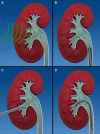Are endourological procedures for nephrolithiasis treatment associated with renal injury? A review of potential mechanisms and novel diagnostic indexes
- PMID: 32905259
- PMCID: PMC7467591
- DOI: 10.1093/ckj/sfaa020
Are endourological procedures for nephrolithiasis treatment associated with renal injury? A review of potential mechanisms and novel diagnostic indexes
Abstract
Nephrolithiasis is one of the most common urological conditions with a huge socio-economic impact. About 50% of recurrent stone-formers have just one lifetime recurrence and >10% of patients present with a high recurrent disease requiring subsequent and sometimes multiple surgical interventions. The advent of new technology has made endourological procedures the pinnacle of stone treatment, including procedures like percutaneous nephrolithotomy (PCNL), retrograde intrarenal surgery and miniaturized PCNL procedures. Researchers have primarily focused on comparisons with respect to stone-free rates, procedure parameters and post-operative complications. However, the effect of these three procedures on renal function or indexes of renal injury has not been sufficiently examined. This was only reported in a few studies as a secondary objective with the use of common and not the appropriate and detailed renal parameters. This review presents current literature regarding the use of novel and highly predictive biomarkers for diagnosing acute kidney injury, discusses potential mechanisms through which endourological procedures for renal stone treatment may affect renal function and proposes areas with open questions where future research efforts in the field should focus.
Keywords: KIM-1; acute kidney injury; endourology; nephrolithiasis; renal function.
© The Author(s) 2020. Published by Oxford University Press on behalf of ERA-EDTA.
Figures


Similar articles
-
The effect of standard percutaneous nephrolithotomy, miniaturized percutaneous nephrolithotomy and retrograde intrarenal surgery on biomarkers of renal injury: a randomized clinical trial.Clin Kidney J. 2023 May 23;16(11):2216-2225. doi: 10.1093/ckj/sfad120. eCollection 2023 Nov. Clin Kidney J. 2023. PMID: 37915926 Free PMC article.
-
Updated evidence of the safety and efficacy of the miniaturized percutaneous nephrolithotomy with holmium laser lithotripsy for the treatment of recurrent nephrolithiasis.Eur Rev Med Pharmacol Sci. 2022 Jun;26(11):3886-3892. doi: 10.26355/eurrev_202206_28956. Eur Rev Med Pharmacol Sci. 2022. PMID: 35731058
-
First 100 Reported Cases of Supine Percutaneous Nephrolithotomy in Malaysia: An Alternative Effective and Safe Approach to Treat Renal Stones.Malays J Med Sci. 2024 Jun;31(3):125-132. doi: 10.21315/mjms2024.31.3.9. Epub 2024 Jun 27. Malays J Med Sci. 2024. PMID: 38984250 Free PMC article.
-
Determining the safety and effectiveness of percutaneous nephrolithotomy and retrograde intrarenal surgery in treating nephrolithiasis in patients with solitary kidneys.Urolithiasis. 2022 Dec 1;51(1):2. doi: 10.1007/s00240-022-01386-3. Urolithiasis. 2022. PMID: 36454348
-
Endoscopic Combined Intrarenal Surgery vs Percutaneous Nephrolithotomy for Large and Complex Renal Stone: A Systematic Review and Meta-Analysis.J Endourol. 2022 Jul;36(7):865-876. doi: 10.1089/end.2021.0761. Epub 2022 Jun 24. J Endourol. 2022. PMID: 35152754
Cited by
-
A warning system for urolithiasis via retrograde intrarenal surgery using machine learning: an experimental study.BMC Urol. 2022 Jun 6;22(1):80. doi: 10.1186/s12894-022-01032-5. BMC Urol. 2022. PMID: 35668401 Free PMC article.
-
The effect of standard percutaneous nephrolithotomy, miniaturized percutaneous nephrolithotomy and retrograde intrarenal surgery on biomarkers of renal injury: a randomized clinical trial.Clin Kidney J. 2023 May 23;16(11):2216-2225. doi: 10.1093/ckj/sfad120. eCollection 2023 Nov. Clin Kidney J. 2023. PMID: 37915926 Free PMC article.
-
Preclinical Studies on the Safety and Toxicity of Photoditazine in the Antibacterial Photodynamic Therapy of Uropathogenic Bacteria.Biomedicines. 2023 Aug 17;11(8):2283. doi: 10.3390/biomedicines11082283. Biomedicines. 2023. PMID: 37626779 Free PMC article.
-
Gadolinium-enhanced MRI visualizing backflow at increasing intra-renal pressure in a porcine model.PLoS One. 2023 Feb 16;18(2):e0281676. doi: 10.1371/journal.pone.0281676. eCollection 2023. PLoS One. 2023. PMID: 36795705 Free PMC article.
-
Effect of access sheath diameter used in percutaneous nephrolithotomy on renal function: a prospective randomized study.Urolithiasis. 2024 Jun 26;52(1):100. doi: 10.1007/s00240-024-01582-3. Urolithiasis. 2024. PMID: 38922347 Clinical Trial.
References
Publication types
LinkOut - more resources
Full Text Sources
Medical

